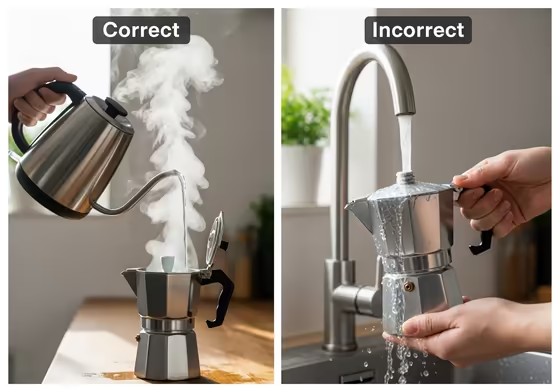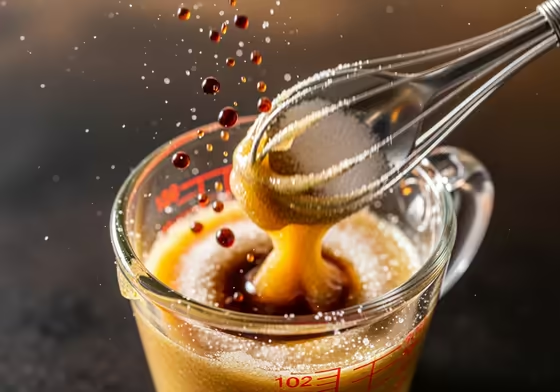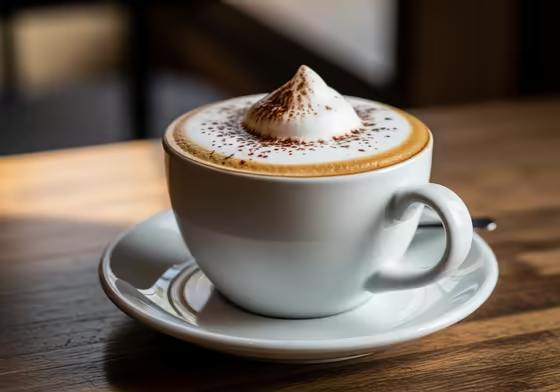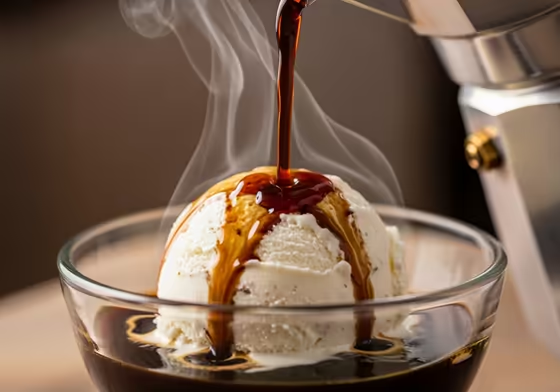5 Easy Moka Pot Recipes for Better Coffee
The moka pot is a famous coffee maker that doesn't cost much. It’s been popular in Italy for decades. It's designed to make strong, espresso-like coffee right on your stovetop.
But many people have a hard time with it. Their coffee often turns out bitter, burnt, or metallic . This usually happens because they follow old brewing methods that don't work well.
The good news is that these problems are easy to fix. A moka pot makes a strong coffee base, but it's not true espresso because it uses low pressure. You just need to learn a few basics about the coffee grind, water amount, and temperature.
Moka Pot Basics

The key to any good moka pot recipe isn't the ingredients, it's the method. You need to get these three things right before you start brewing.
Choosing the Right Coffee
The first mistake people make is using the wrong coffee. The grind size and roast level are very important.
What's the best coffee grind?
The best grind for a moka pot is medium-fine . This is the most important part of making good coffee.

- How it should feel: The coffee grounds should feel like granulated sugar or table salt . It shouldn't be a fine powder like flour or coarse like sea salt.
- Why not use an espresso grind: A fine espresso grind is a common mistake. It is too dense and will clog the pot. This makes the coffee brew too slowly and taste very bitter.
- Why not use a drip grind: A coarse drip grind will lead to weak coffee. The water flows through the grounds too quickly. This makes the coffee taste watery and sour.
- How to get it right: "Medium-fine" is just a starting point. The taste of your coffee tells you if you need to make changes.
- If your coffee tastes bitter or burnt : Your grind is too fine. The water was in contact with the coffee for too long. Make your grind a little coarser next time.
- If your coffee tastes weak or sour : Your grind is too coarse. The water rushed through too quickly. Make your grind a little finer.
Is pre-ground coffee okay?
Freshly ground coffee is always best, but pre-ground is okay if you buy the right kind.
- The problem with pre-ground: Most pre-ground coffee is for drip machines, which is too coarse. This will make your moka pot coffee taste sour. Some pre-ground "espresso" is too fine, which can make it taste bitter.
- What to buy: Look for bags that say "moka pot grind" or "per moka." Italian brands are often a safe bet. Brands like Lavazza Crema e Gusto, Kimbo, and Café Bustelo usually work well.
- Roast level: Most people prefer medium-dark or dark roasts . Lighter roasts can have a sour taste that the moka pot makes stronger.
- A quick tip: If your pre-ground coffee is too fine and clogs the pot, just use less of it. Don't fill the basket all the way to the top. This helps the water pass through more easily.
Coffee and Water Ratios
This is where a lot of people get confused. You might see guides talking about specific ratios like 1:10. You can ignore them.
The Truth About Moka Pot Ratios
Here's the most important thing to know: you don't choose the ratio. The size of your moka pot does. Each pot is built to hold a specific amount of water and coffee.
Trying to use less water or less coffee will just mess up the brew. The only "recipe" is to fill each part to the level it was designed for.
- Water: Fill the bottom chamber with water up to the bottom of the safety valve. Do not cover the valve.
- Coffee: Fill the funnel basket with coffee grounds until they are level with the rim.
The biggest mistake is tamping the coffee. Never press or pack the grounds down. This makes the coffee too dense, which clogs the pot and makes the brew bitter.
How Much Coffee and Water to Use
Since the ratio is set by the pot, the real question is how much your pot holds. Moka pot "cup" sizes are small, about 50 ml, not a normal coffee mug. Here are some common sizes.
Table 1: Moka Pot Sizes and Amounts
| Moka Pot "Cup" Size | Approx. Water Input | Approx. Coffee Dose | Approx. Final Yield | Best For |
|---|---|---|---|---|
| 1-Cup | ~60 ml | ~5-7 g | ~30-40 ml | One Affogato (Recipe 5) |
| 3-Cup | ~150 ml | ~15-18 g | ~100-120 ml | One Latte/Cappuccino (Recipe 2/4) |
| 6-Cup | ~300 ml | ~27-30 g | ~250-280 ml | Two Lattes or one Americano |
| 9-Cup | ~450 ml | ~35-40 g | ~380-420 ml | A group of 3-4 people |
Ratios for Lattes and Milk Drinks
When you see ratios for lattes, they mean the amount of brewed coffee to milk. The brewing ratio inside the pot itself does not change.
- The Standard: A good ratio for a hot latte is 1 part moka pot coffee to 3 parts frothed milk . So, your drink would be about 1/3 coffee and 2/3 milk.
- Variations: For a stronger drink, you can use a 1:1 ratio of coffee to milk. Iced lattes also work well with the 1:3 ratio.
Key Brewing Tips
These last three tips are the final step to getting rid of bitter coffee.
Use Hot Water, Not Cold
This is a big debate, but the answer is pretty clear.

- The Old Way (Cold Water): Many traditional guides and home brewers start with cold water.
- The Better Way (Hot Water): Nearly all coffee experts agree that you should start with pre-heated water . Use water that is hot but not boiling.
- Why Hot Water is Better: When you start with cold water, the whole metal pot sits on the stove for a long time. This "bakes" the dry coffee grounds before the water even hits them. This gives the coffee a burnt, metallic taste .
When to Stop Brewing
How long it takes to brew isn't as important as knowing when to stop. With hot water, your coffee can be ready in 2-3 minutes.
The biggest mistake is brewing for too long. That sputtering sound at the end is a bad sign. It means super-heated steam is being forced through the grounds, which makes your coffee bitter.
You should watch the coffee as it brews with the lid open. When the stream of coffee changes from a dark brown to a light, honey-yellow color , take it off the heat immediately. Do not wait for it to sputter.
The "Traditional" Italian Method (and Why to Avoid It)
It helps to know the old Italian method because it explains why moka pot coffee is often bitter. The common way it's done in many homes is a recipe for bad coffee.
- Using cold tap water.
- Mounding extra coffee in the basket.
- Putting the pot on high heat.
- Letting it brew until it sputters loudly.
This method creates burnt coffee. Many people who grew up with this taste got used to it. The modern tips in this guide will give you a much sweeter and more balanced cup.
5 Simple Moka Pot Recipes

These recipes use the basics we just covered. The first recipe is the main one you need to learn. All the other recipes start with this one.
Recipe 1: The Basic Moka Pot Brew
This recipe puts all the best practices together. It makes a rich, strong, and sweet coffee concentrate.
What You'll Need:
- Moka Pot (any size)
- Medium-fine ground coffee
- Filtered water, just off the boil
- A towel or oven mitt
Step-by-Step Instructions:
- Heat Water: Bring filtered water to a near-boil in a kettle.
- Fill the Base: Carefully pour the hot water into the moka pot's bottom chamber. Fill it to just below the safety valve.
- Add Coffee: Put the funnel in the base. Fill it with coffee until it's level with the top. Do not press the coffee down.
- Assemble: Use a towel to screw the top chamber tightly onto the hot base.
- Brew: Place the moka pot on a low to medium-low heat . High heat will make the coffee taste bitter.
- Watch: Leave the lid open so you can see the coffee. After a minute or two, a rich, dark brown stream of coffee will start to come out.
- Stop: This is the most important step. When the coffee stream's color lightens to a pale yellow, take the pot off the heat right away. Do not wait for the sputtering sound.
- Cool Down (Pro Tip): To stop the brewing instantly, run the bottom of the pot under cold tap water. This locks in the sweet flavors.
- Serve (Pro Tip): Stir the coffee in the top chamber before you pour. This mixes everything together for a balanced taste.
Recipe 2: How to Make a Latte

This recipe uses the moka pot coffee to create a latte like you'd get at a cafe.
What You'll Need:
- 1 batch of "Basic Moka Pot Brew" (a 3-cup pot is good for one latte)
- 6-8 oz (180-240ml) Milk
- Something to froth the milk, like a French Press, Mason Jar, or Handheld Wand
For the best foam, use whole milk . If you prefer plant-based milk, "Barista Blend" oat milk is a great choice because it froths well.
Step-by-Step Instructions:
- Brew Coffee: Make one batch of the basic brew from Recipe 1.
- Heat Milk: While the coffee is brewing, gently heat your milk. It should be hot to the touch, but not boiling.
-
Froth Milk:
- French Press: Pour hot milk into a clean French press. Pump the plunger up and down for 10-15 seconds to create a silky foam.
- Mason Jar: Pour hot milk into a jar (fill it less than halfway). Screw the lid on tight and shake it hard for 30 seconds.
- Hand Wand: Put a frothing wand into the hot milk and blend until it's foamy.
- Combine: Pour the fresh moka pot coffee into a mug. Gently pour the frothed milk over the coffee. A good ratio is 1 part coffee to 3 parts milk.
Recipe 3: Cuban Coffee (Café Cubano)

This is a traditional Cuban drink that's very sweet and strong. It's topped with a thick foam called espuma .
The trick to this drink is the foam. It's made by beating sugar with the first few drops of coffee.
What You'll Need:
- 1 batch of "Basic Moka Pot Brew" (a 6-cup pot is traditional)
- 1/4 cup (about 4 tablespoons) of white sugar
- A small pitcher or heat-proof measuring cup
Step-by-Step Instructions:
- Prep: Put the sugar into your measuring cup or pitcher.
- Brew: Start brewing your coffee using the method from Recipe 1.
- Catch the First Drops: Watch the spout closely. As soon as the first few thick drops of coffee come out, pour about a teaspoon of it over the sugar.
- Finish Brewing and Whisk: Put the moka pot back on the heat. At the same time, start beating the sugar and coffee mixture with a spoon.
- Make the Foam: Whisk the mixture very fast for 1-2 minutes. It will turn from a dark, gritty mix into a thick, pale, caramel-colored paste. This is the espuma .
- Combine: Once the moka pot is done brewing, slowly pour the rest of the hot coffee into the pitcher with the foam paste. Stir gently as the foam rises.
- Serve: Pour the Café Cubano into small cups and serve right away.
Recipe 4: How to Make a Cappuccino

A cappuccino is different from a latte. It has a specific ratio and foam texture. This recipe shows you how to make a classic Italian one.
A cappuccino has three equal parts: coffee, steamed milk, and stiff foam . The foam is thick and you can scoop it with a spoon.
What You'll Need:
- 1 batch of "Basic Moka Pot Brew" (from a 3-cup pot)
- 4 oz (120ml) Cold Milk
- Cocoa or Cinnamon powder (optional)
Step-by-Step Instructions:
- Brew Coffee: Make coffee using a 3-cup moka pot. This will give you about 2 oz of coffee.
- Heat Milk: Gently heat the milk, just like in the latte recipe.
- Froth Foam: Froth the milk longer and harder than you would for a latte. You want to create a stiff, dense foam.
-
Assemble the Drink:
- Pour the 2 oz of coffee (1/3) into a cappuccino cup.
- Gently pour in about 2 oz of hot liquid milk (1/3).
- Use a spoon to scoop about 2 oz of the thick foam (1/3) on top.
- Serve: You can sprinkle a little cocoa powder or cinnamon on top if you like.
Recipe 5: Iced Vanilla Latte
This recipe shows you how to make a coffee shop-style iced latte. It's a popular way to use moka pot coffee.
The key to a good iced drink is the order you add things. Mix the syrup and coffee first, then add the cold milk.

What You'll Need:
- 1 batch of "Basic Moka Pot Brew", cooled for a few minutes
- 1-2 tbsp Vanilla Syrup (or any flavor you like)
- 4-6 oz Cold Milk
- A tall glass
Step-by-Step Instructions:
- Brew Coffee: Make your coffee using Recipe 1. Let it cool for a couple of minutes.
-
Build the Drink:
- Fill a tall glass all the way with ice.
- Add 1-2 tablespoons of vanilla syrup to the glass.
- Pour the brewed moka pot coffee over the ice.
- Fill the rest of the glass with cold milk.
- Stir and Serve: Stir the drink to mix the coffee, syrup, and milk together.
Bonus: The Affogato
This is a super simple and popular Italian dessert.

- How to make it: Put one large scoop of vanilla ice cream in a small bowl. Brew a fresh, hot "shot" of coffee from a small moka pot. Pour the hot coffee directly over the ice cream and serve immediately.
How to Fix Common Problems
If your moka pot coffee doesn't taste good, it's usually for one of three reasons. It's either over-extracted (bitter), under-extracted (weak), or the pot is dirty. Here's how to fix each problem.
Problem: My Coffee Tastes Bitter or Burnt
- The Symptom: This is the number one complaint. The coffee tastes harsh, very bitter, or burnt.
- The Cause: This is called over-extraction . The hot water was touching the coffee for too long or was too hot.
- The 4 Fixes:
- Stop Brewing Sooner: If you wait for the sputtering sound, you've waited too long. That sound is steam burning the coffee. Take the pot off the heat as soon as the coffee stream turns light yellow.
- Use Lower Heat: Brewing on high heat burns the coffee. Use low to medium-low heat for a gentle, slow brew.
- Use Pre-Heated Water: Starting with cold water bakes the coffee grounds before the brewing even starts. Use hot water to reduce the time the pot spends on the stove.
- Grind Coarser: Your grind is probably too fine. A finer grind can clog the pot and make the coffee bitter. Try making the grind one step coarser.
Problem: My Coffee is Weak, Watery, or Sour
- The Symptom: The coffee tastes like weak "coffee water" or has a sharp, sour taste.
- The Cause: This is called under-extraction . The water went through the grounds too fast and didn't pull out enough flavor.
- The 3 Fixes:
- Grind Finer: Your grind is too coarse. The water is just rushing through. Make the grind finer to slow the water down.
- Fill the Basket: You must fill the coffee basket all the way to the top. If it's only half-full, the water will flow through too quickly. To make less coffee, you need to use a smaller moka pot.
- Check Your Seal: If steam is leaking from the middle of the pot, you're losing pressure. Make sure the pot is screwed on tight. If it still leaks, you may need to replace the rubber gasket.
Problem: My Coffee Tastes Metallic or Just... Bad
- The Symptom: The coffee has a sharp metallic flavor or tastes stale.
- The Cause: The pot is dirty or you are using bad water.
- The 2 Fixes:
-
Clean Your Pot (It's a Myth You Shouldn't): The idea that you shouldn't wash a moka pot is wrong. Old coffee oils don't "season" the pot, they go bad and ruin your coffee.
Myth Busted: Always clean your moka pot after each use. The belief that old coffee oils "season" the pot is false. Those oils go rancid and make your coffee taste bad. A clean pot is essential for good flavor.
- Daily Cleaning: After each use, let the pot cool and take it apart. Rinse all the parts with hot water. Dry everything completely before putting it back together to prevent mold.
- Deep Cleaning: Every so often, you need to descale the pot. Fill the bottom with a 50/50 mix of white vinegar and water. Brew it without any coffee, then throw the mix out. Brew 1-2 more times with plain water to rinse it.
- Check for Gunk: You also need to remove the rubber gasket and filter screen in the top part. Oily gunk and mold can get trapped behind them. Scrub these parts clean.
- Use Filtered Water: Tap water can have minerals that react with the pot's aluminum. This can create a metallic taste. Switching to filtered or bottled water can solve this.